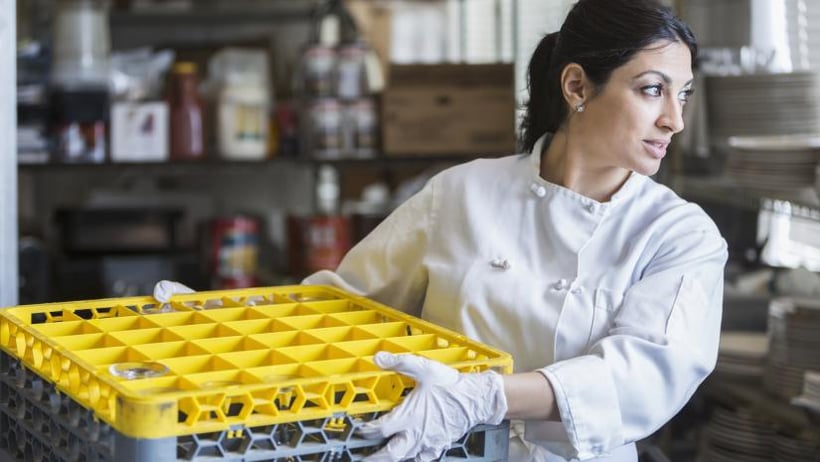
Regular cleaning and sanitizing is essential to ensuring food safety anywhere where food is handled, from full-service restaurants and hotels to hospitals and care facilities.
Many food-borne illness outbreaks occur as a result of poor cleaning and sanitizing procedures, and different items will require a different approach.
When deciding on the best approach to take, you’ll need to consider:
- the item to be cleaned
- the type of soiling
- your water supply
- water temperature
- appropriate cleaning and sanitizing agents
The three most common cleaning methods used in commercial kitchens are:
- Manual cleaning
- Mechanical cleaning
- Clean-in-place cleaning
Note: To ensure food safety, cleaning must always be followed by sanitizing. For the purpose of this article, "cleaning" refers to cleaning and sanitizing.
Manual cleaning
Manual cleaning is a 6 or 7 step process, depending on the sanitizing method you use. It involves:
- removing dirt, grease and food scraps
- rinsing
- cleaning with an appropriate cleaning agent (e.g. detergent, degreaser)
- sanitizing using a chemical sanitizer or hot water
- air drying
Visual reminders of the cleaning and sanitizing process, as well as quick reference guides for cleaning and sanitizing agents, can be very useful for staff training and ensuring food safety in a commercial kitchen or community feeding organization.
CIFS Members can download these resources and more from the CIFS Resource Library. Learn about the benefits of CIFS Membership.
Mechanical cleaning
Mechanical cleaning involves using a dishwasher or other automated cleaning equipment. Most food businesses use a combination of manual and mechanical cleaning and sanitizing.
Some machines use a high-temperature rinse to sanitize, while others use a chemical sanitizer.
If using a mechanical dishwasher to clean and sanitize items, the steps are similar to manual cleaning. You’ll want to scrape and rinse off as much food residue as you can before loading the machine.
Avoid overloading the machine, as this can prevent items from getting properly cleaned and puts unnecessary wear and tear on the machine.
Depending on the sanitizing method used by your machine, you’ll want to perform the following checks daily:
- maximum water temperature
- chemical concentration
Always follow the manufacturer’s instructions for your mechanical dishwasher and keep it in good repair. Failure to do so could cost you points on your next health inspection.
Clean-in-place cleaning
Some kitchen equipment is designed to be ‘cleaned in place’. Clean-in-place cleaning is generally done if the item being cleaned is too large or too cumbersome to be moved, or if it is fixed in place.
For example:
- soft serve ice cream machines
- pop dispensers
- espresso machines
These types of machines are usually designed with pipes or other apparatus that allow cleaners/sanitizers and hot water to be flushed through the system, eliminating built-up grime and microorganisms.
Always follow the manufacturer’s instructions to avoid damaging the machines or contaminating food/beverages with harsh chemicals that could make somebody sick.
The importance of cleaning and sanitizing
Cleaning and sanitizing food premises is crucial. If you or your Food Handlers are not adequately cleaning and sanitizing, you’re putting your customers and your business at risk.
Food Handlers must receive food safety training to ensure they know how, what and when to clean and sanitize, as well as the risks of not following proper procedures.
Food safety training also makes good business sense, because effective cleaning and sanitizing:
- prevents pest infestations, which can increase operational costs and damage your reputation;
- helps to ensure that your business/organization passes its health inspections and avoids costly fines or closure;
- helps to protect customers/clients/care recipients from food poisoning and other health risks, like allergic reactions to food.
Food poisoning can cause severe illness or even death. Frequent, rigorous cleaning and sanitizing will help to prevent this from happening in your business or workplace.
To learn more about food safety training, contact the Canadian Institute of Food Safety.




